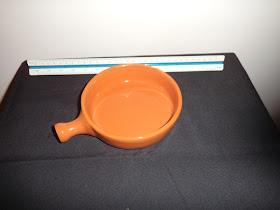Designer
|
Bette Beazley
|
Maker
|
Bette Beazley
|
Marks
|
Stamped “BB” inside circle. Letters had trailing line from end of “B”
|
Material
|
Glazed Earthenware
|
Description
|
Hand thrown glazed earthenware
bowl with scooped (similar to Arabia) handle angled slightly upwards from
centre of exterior of bowl. Brown
matte glaze to interior and exterior. Unglazed base.
|
Condition
|
Very good
|
Number
|
No number
|
Production Date
|
1980s
|
Width at rim
|
107mm
|
Width at Base
|
65mm
|
Depth
|
45mm
|
Length (with handle)
|
160mm
|
Weight
|
320gm
|
Volume
|
325ml
|
Acquisition
|
Purchase
Red Cross, Hampstead Gardens SA
19 December 2014.
|
Rameking Reference Number
|
BEA 001-003
|
Bette Beazley was a
prolific potter worked first at Long Jetty in the Gosford area on the central
coast of NSW from the 1960s to the 1980s. She made works in a wide variety of styles and sold her wares and taught pottery, first from her home, then from an
A-Frame studio she had built at 310 The Entrance Road, Long Jetty. In the late
1980s she relocated to Sal’s Lane, on a semi-rural property in nearby Tumbi
Umbi. Her painted pieces usually featured delicate
designs of Australian wildflowers, while her more modern plates and vases often
displayed incised or impressed decoration. She also made pieces with applied
floral decoration, and even a range of garden ornaments, with dragons and other
fantasy creatures.
She continued making pottery there using an electric kiln
in a small studio at the rear of the house and another kiln outside. She made thrown and handmade pieces
influenced by the ocean as well as whimsical figurative sculptures, including
dragons. She signed her works with either an incised, painted or stamped
'BB'. These works were sold from the
pottery and through local galleries and gift shops. A small number of her work was marked as “Woodbine Studios”.
She ceased working in 1988 when her home was sold, along
with her pottery equipment before moving again. Bette and her husband Viv (Vivian George) a retired motor
mechanic then moved to Bateau Bay, close to their old home at Long Jetty. Bette died around 1997 with Viv passing away
about a year later. Any further information would be appreciated.
Thanks to Australian Pottery at Bemboka for much of this information.









.JPG)












